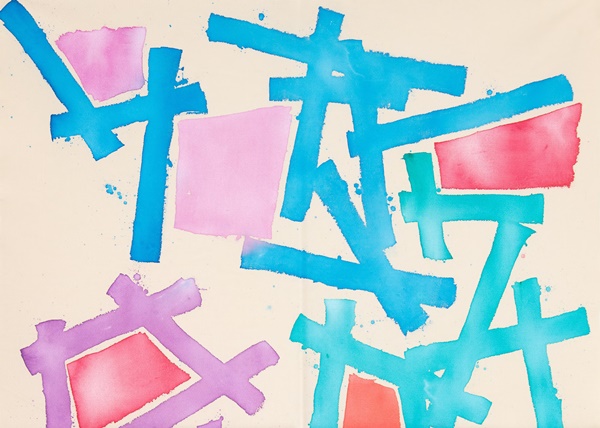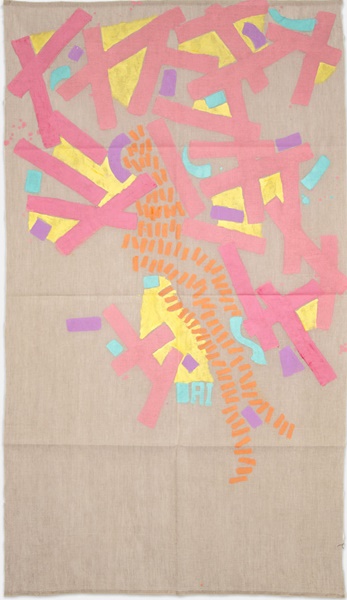HUFKENS XAVIER,BRUXELLES , BELGIUM - Giorgio Griffa : Empatia - 13 September > 26 October, 2024
Empatia
Giorgio Griffa

HUFKENS XAVIER
107 rue St-Georges St-Jorisstraat 1050 Brussels, Belgium+32 (0)2 639 67 30 e-mail:
OVERVIEW :
A second nearby space opened in the spring of 2013. Located in the Galerie Rivoli, an iconic Seventies-era building, the new gallery space was designed by Swiss architect Harry Gugger, who was previously in partnership with Herzog and De Meuron. The Rivoli gallery has hosted solo exhibitions by Paul McCarthy, Nicolas Party, Danh V?, Cathy Wilkes and Zhang Enli, among many others. In 2014, Xavier Hufkens began its ongoing collaboration with Belgian artist Walter Swennen, and with acclaimed British artist Tracey Emin the following year. The gallery has long been active in the publication of catalogues and monographs on the work of its artists.
gallery's Multiple Locations :Brussels (3)
13 September > 26 October, 2024




Giorgio Griffa Empatia


Giorgio Griffa Disordine AI, 2023
![click to enlarge- double click to reduce]()
ABOUT EXHIBITION : Empatia
Xavier Hufkens is pleased to announce its second gallery exhibition with Giorgio Griffa (b. 1936, Turin) curated by Yann Chateigné Tytelman. Titled Empatia, this new presentation with the artist connects two groups of works created over 50 years apart, demonstrating the italian painter’s great coherence, relentless creativity, and ongoing ability for renewal.
Between 1967 and 1968, Giorgio Griffa, who until then had been practicing landscape painting in the spirit of De Chirico’s Magic Realism, underwent a revolution in his way of working. He abandoned figuration and established a production protocol that he has adhered to until today. The unprimed canvas is laid flat on the floor. Without any preparatory drawing, Griffa paints direcly onto the raw canvas, standing upright, creating simple forms that gradually occupy the surface.
The marks — horizontal lines, oblique strokes, spirals, numbers, letters, or words — organise, combine, and compose themselves. New patterns appear in waves, while others fade and reappear, forming cycles of paintings (13 to date) that interact and “contaminate” each other, imbuing the work with a dynamic, evolving, and almost musical essence.
The composition, always initiated in the upper left corner of the painting, gradually unfolds across the support and then stops at a moment the artist deems appropriate, leaving the work suspended, deliberately “unfinished.” This deliberate pause, an act of great restraint, exposes the material process of painting in all its vulnerability; and invites the viewer to participate in its completion. It embodies a search for equilibrium, a point of dynamic instability that underscores Griffa’s intention for each work to serve as a fragment of a larger, ongoing endeavour — a galaxy-like oeuvre in perpetual reconfiguration and renewal.
The work is then numbered and inventoried. Each painting is folded and meticulously stored, waiting to be shown. As a result, the canvases bear visible creases, a characteristic hallmark of their economy. The reduction of means that underpins Griffa’s production is also evident in how the artist displays his works. The canvases, without stretchers or frames, are freely nailed to the wall, discreetly secured at the top edge with a few nails. This radical simplicity allows observers to see how the fluidity of material permeates the raw linen in a tactile manner. The luminous colours, ranging from soft and pastel to bright and acidic tones, contrast with the subdued neutrality of the beige and brown hues of the canvas.
Griffa’s pictorial language, seemingly rational, materialistic, and deconstructive, has occassionally led critics to associate his work with various conceptual and critical movements of the 1970s—such as “cold painting,” “planned” or “analytic” painting, Arte Povera, Minimalism, and Supports/Surfaces. Later, in the 2000s, emphasis was placed on a poetics of emptiness, an aesthetics of withdrawal. While these aspects are present within his oeuvre, the exhibition also aims to reveal the extent to which the artist’s world, rooted in observation of nature, relies on a ritual of patience, nearly scientific precision, and a vital movement inherent within the work. This connection possibly traces back to the origins of his practice: the representation of nature, the movements of air and light, and the lines and marks inscribed in the landscape.
ABOUT ARTISTS : Giorgio Griffa
Giorgio Griffa (b. 1936, Turin; lives and works in Turin) participated in important international exhibitions such as Prospekt, Düsseldorf (1969 and 1974) and the Venice Biennale (1978, 1980 and in 2017) as well as Processes of Visualized Thought: Young Italian Avant-garde, Kunstmuseum Luzern (1970) and A Painting Exhibition of Painters who Place Painting in Question, curated by Michel Claura, Stadtische Museum, Monchengladbach (1973). A selection of recent solo exhibitions were held at Castello di Mirandolo, San Secondo di Pinerolo (2024); Centre Pompidou, Paris (2022); Villa Romana, Florence (2022); LaM - Lille Métropole Musée d’art moderne, Villeneuve-d’Ascq (2021); Palazzo Collicola, Spoleto (2020-21); Camden Art Centre, London (2018); Mies van der Rohe Haus, Berlin (2012); and MACRO, Museo d’Arte Contemporanea, Rome (2011).
 Giorgio Griffa
Giorgio Griffa 
ABOUT EXHIBITION : Empatia
Xavier Hufkens is pleased to announce its second gallery exhibition with Giorgio Griffa (b. 1936, Turin) curated by Yann Chateigné Tytelman. Titled Empatia, this new presentation with the artist connects two groups of works created over 50 years apart, demonstrating the italian painter’s great coherence, relentless creativity, and ongoing ability for renewal.
Between 1967 and 1968, Giorgio Griffa, who until then had been practicing landscape painting in the spirit of De Chirico’s Magic Realism, underwent a revolution in his way of working. He abandoned figuration and established a production protocol that he has adhered to until today. The unprimed canvas is laid flat on the floor. Without any preparatory drawing, Griffa paints direcly onto the raw canvas, standing upright, creating simple forms that gradually occupy the surface.
The marks — horizontal lines, oblique strokes, spirals, numbers, letters, or words — organise, combine, and compose themselves. New patterns appear in waves, while others fade and reappear, forming cycles of paintings (13 to date) that interact and “contaminate” each other, imbuing the work with a dynamic, evolving, and almost musical essence.
The composition, always initiated in the upper left corner of the painting, gradually unfolds across the support and then stops at a moment the artist deems appropriate, leaving the work suspended, deliberately “unfinished.” This deliberate pause, an act of great restraint, exposes the material process of painting in all its vulnerability; and invites the viewer to participate in its completion. It embodies a search for equilibrium, a point of dynamic instability that underscores Griffa’s intention for each work to serve as a fragment of a larger, ongoing endeavour — a galaxy-like oeuvre in perpetual reconfiguration and renewal.
The work is then numbered and inventoried. Each painting is folded and meticulously stored, waiting to be shown. As a result, the canvases bear visible creases, a characteristic hallmark of their economy. The reduction of means that underpins Griffa’s production is also evident in how the artist displays his works. The canvases, without stretchers or frames, are freely nailed to the wall, discreetly secured at the top edge with a few nails. This radical simplicity allows observers to see how the fluidity of material permeates the raw linen in a tactile manner. The luminous colours, ranging from soft and pastel to bright and acidic tones, contrast with the subdued neutrality of the beige and brown hues of the canvas.
Griffa’s pictorial language, seemingly rational, materialistic, and deconstructive, has occassionally led critics to associate his work with various conceptual and critical movements of the 1970s—such as “cold painting,” “planned” or “analytic” painting, Arte Povera, Minimalism, and Supports/Surfaces. Later, in the 2000s, emphasis was placed on a poetics of emptiness, an aesthetics of withdrawal. While these aspects are present within his oeuvre, the exhibition also aims to reveal the extent to which the artist’s world, rooted in observation of nature, relies on a ritual of patience, nearly scientific precision, and a vital movement inherent within the work. This connection possibly traces back to the origins of his practice: the representation of nature, the movements of air and light, and the lines and marks inscribed in the landscape.
ABOUT ARTISTS : Giorgio Griffa
Giorgio Griffa (b. 1936, Turin; lives and works in Turin) participated in important international exhibitions such as Prospekt, Düsseldorf (1969 and 1974) and the Venice Biennale (1978, 1980 and in 2017) as well as Processes of Visualized Thought: Young Italian Avant-garde, Kunstmuseum Luzern (1970) and A Painting Exhibition of Painters who Place Painting in Question, curated by Michel Claura, Stadtische Museum, Monchengladbach (1973). A selection of recent solo exhibitions were held at Castello di Mirandolo, San Secondo di Pinerolo (2024); Centre Pompidou, Paris (2022); Villa Romana, Florence (2022); LaM - Lille Métropole Musée d’art moderne, Villeneuve-d’Ascq (2021); Palazzo Collicola, Spoleto (2020-21); Camden Art Centre, London (2018); Mies van der Rohe Haus, Berlin (2012); and MACRO, Museo d’Arte Contemporanea, Rome (2011).
 Giorgio Griffa
Giorgio Griffa Artist's site : https://www.archiviogiorgiogriffa.it/
Artist's mail :
Artist's CITY :TURIN TO
Artist's COUNTRY :ITALY
Opening reception :Opening Thursday, 12 September
Gallery Opening Hours : Tue-Sat 11am-6pm
mpefm BELGIUM art press release
QR of this press release
in your smartphone, tablet

https://mpefm.com/mpefm/images/0QRcode/qr_7928.png







